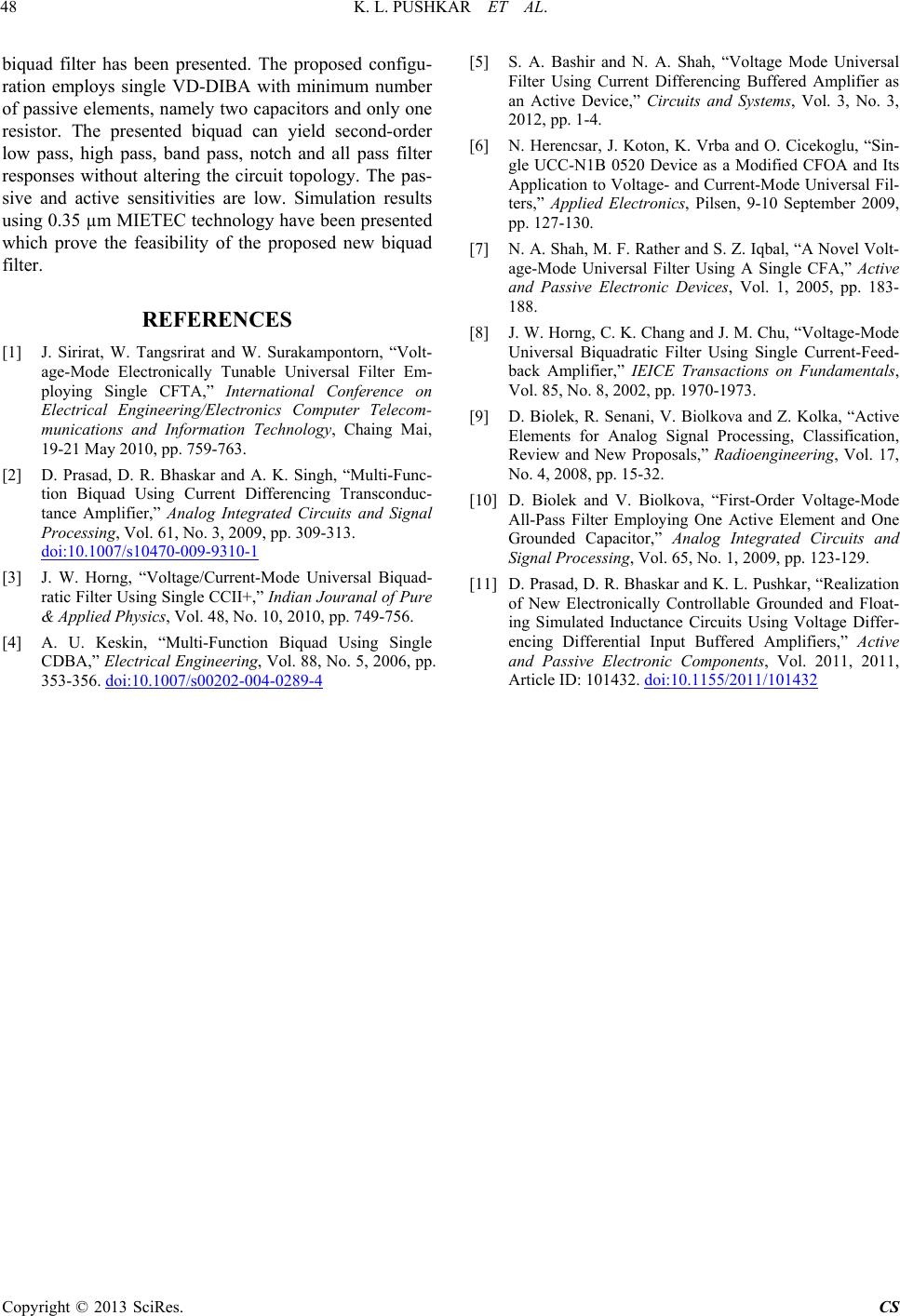
K. L. PUSHKAR ET AL.
48
biquad filter has been presented. The proposed configu-
ration employs single VD-DIBA with minimum number
of passive elements, namely two capacitors and only one
resistor. The presented biquad can yield second-order
low pass, high pass, band pass, notch and all pass filter
responses without altering the circuit topology. The pas-
sive and active sensitivities are low. Simulation results
using 0.35 µm MIETEC technology have been presented
which prove the feasibility of the proposed new biquad
filter.
REFERENCES
[1] J. Sirirat, W. Tangsrirat and W. Surakampontorn, “Volt-
age-Mode Electronically Tunable Universal Filter Em-
ploying Single CFTA,” International Conference on
Electrical Engineering/Electronics Computer Telecom-
munications and Information Technology, Chaing Mai,
19-21 May 2010, pp. 759-763.
[2] D. Prasad, D. R. Bhaskar and A. K. Singh, “Multi-Func-
tion Biquad Using Current Differencing Transconduc-
tance Amplifier,” Analog Integrated Circuits and Signal
Processing, Vol. 61, No. 3, 2009, pp. 309-313.
doi:10.1007/s10470-009-9310-1
[3] J. W. Horng, “Voltage/Current-Mode Universal Biquad-
ratic Filter Using Single CCII+,” Indian Jouranal of Pure
& Applied Physics, Vol. 48, No. 10, 2010, pp. 749-756.
[4] A. U. Keskin, “Multi-Function Biquad Using Single
CDBA,” Electrical Engineering, Vol. 88, No. 5, 2006, pp.
353-356. doi:10.1007/s00202-004-0289-4
[5] S. A. Bashir and N. A. Shah, “Voltage Mode Universal
Filter Using Current Differencing Buffered Amplifier as
an Active Device,” Circuits and Systems, Vol. 3, No. 3,
2012, pp. 1-4.
[6] N. Herencsar, J. Koton, K. Vrba and O. Cicekoglu, “Sin-
gle UCC-N1B 0520 Device as a Modified CFOA and Its
Application to Voltage- and Current-Mode Universal Fil-
ters,” Applied Electronics, Pilsen, 9-10 September 2009,
pp. 127-130.
[7] N. A. Shah, M. F. Rather and S. Z. Iqbal, “A Novel Volt-
age-Mode Universal Filter Using A Single CFA,” Active
and Passive Electronic Devices, Vol. 1, 2005, pp. 183-
188.
[8] J. W. Horng, C. K. Chang and J. M. Chu, “Voltage-Mode
Universal Biquadratic Filter Using Single Current-Feed-
back Amplifier,” IEICE Transactions on Fundamentals,
Vol. 85, No. 8, 2002, pp. 1970-1973.
[9] D. Biolek, R. Senani, V. Biolkova and Z. Kolka, “Active
Elements for Analog Signal Processing, Classification,
Review and New Proposals,” Radioengineering, Vol. 17,
No. 4, 2008, pp. 15-32.
[10] D. Biolek and V. Biolkova, “First-Order Voltage-Mode
All-Pass Filter Employing One Active Element and One
Grounded Capacitor,” Analog Integrated Circuits and
Signal Processing, Vol. 65, No. 1, 2009, pp. 123-129.
[11] D. Prasad, D. R. Bhaskar and K. L. Pushkar, “Realization
of New Electronically Controllable Grounded and Float-
ing Simulated Inductance Circuits Using Voltage Differ-
encing Differential Input Buffered Amplifiers,” Active
and Passive Electronic Components, Vol. 2011, 2011,
Article ID: 101432. doi:10.1155/2011/101432
Copyright © 2013 SciRes. CS